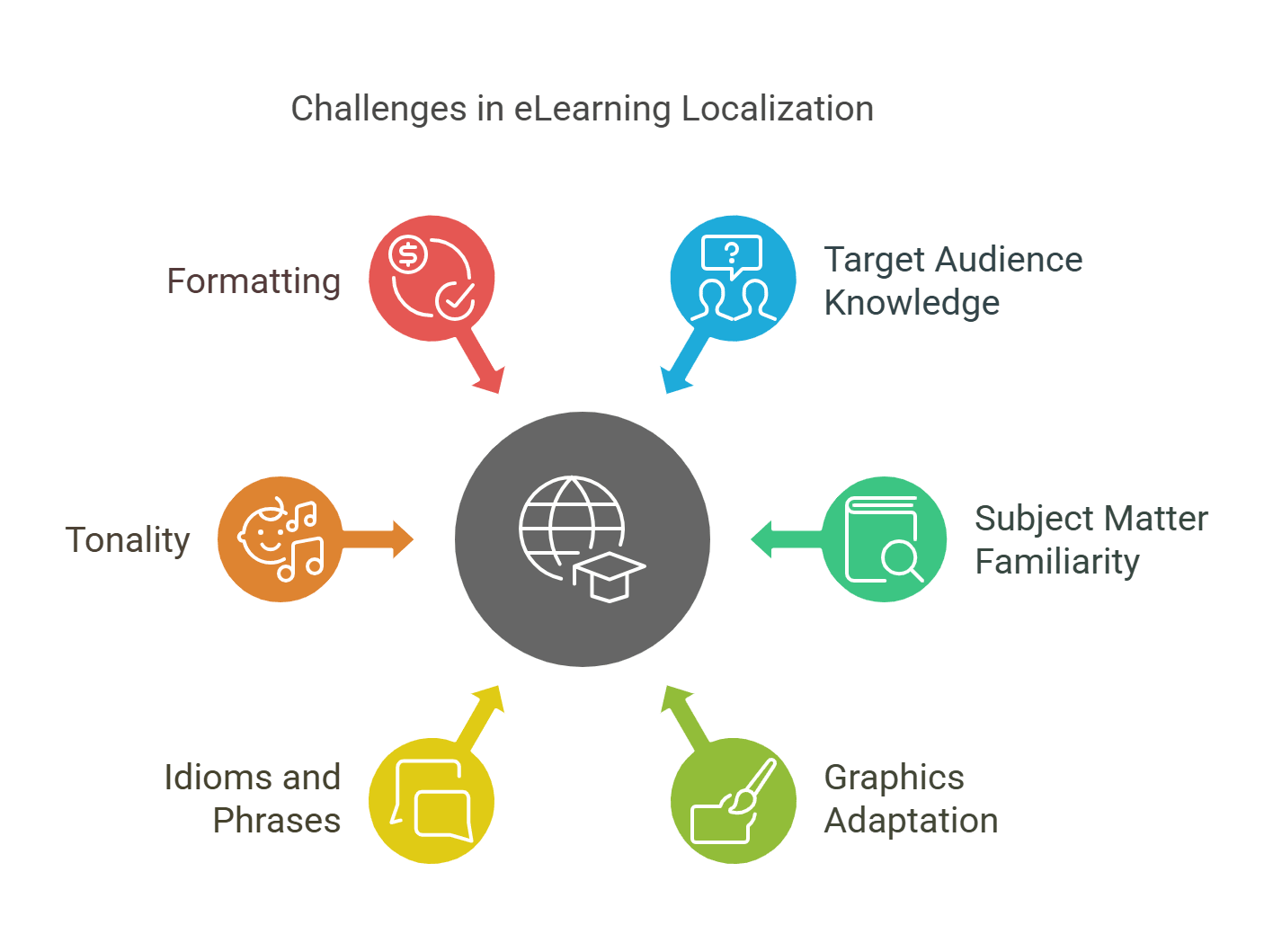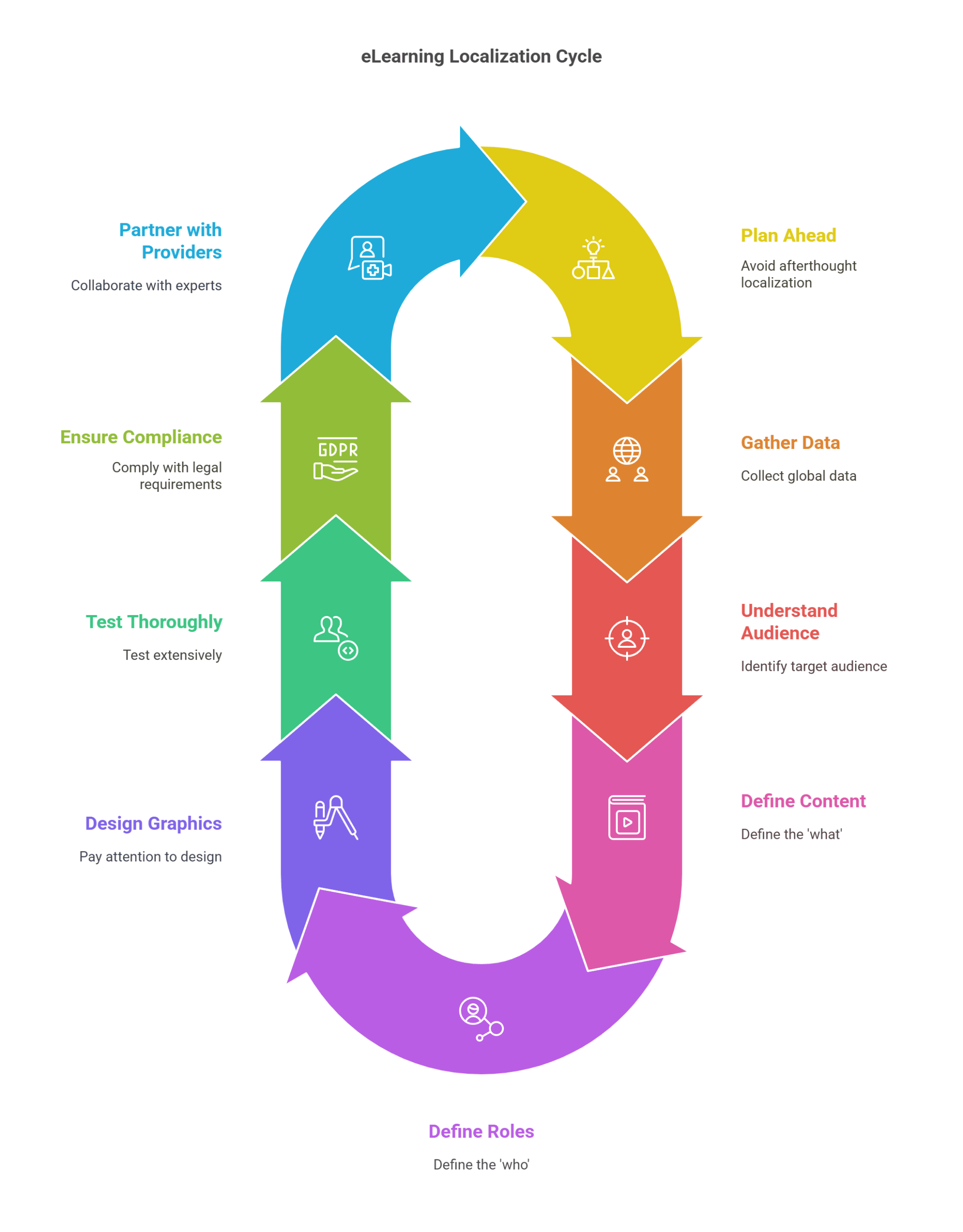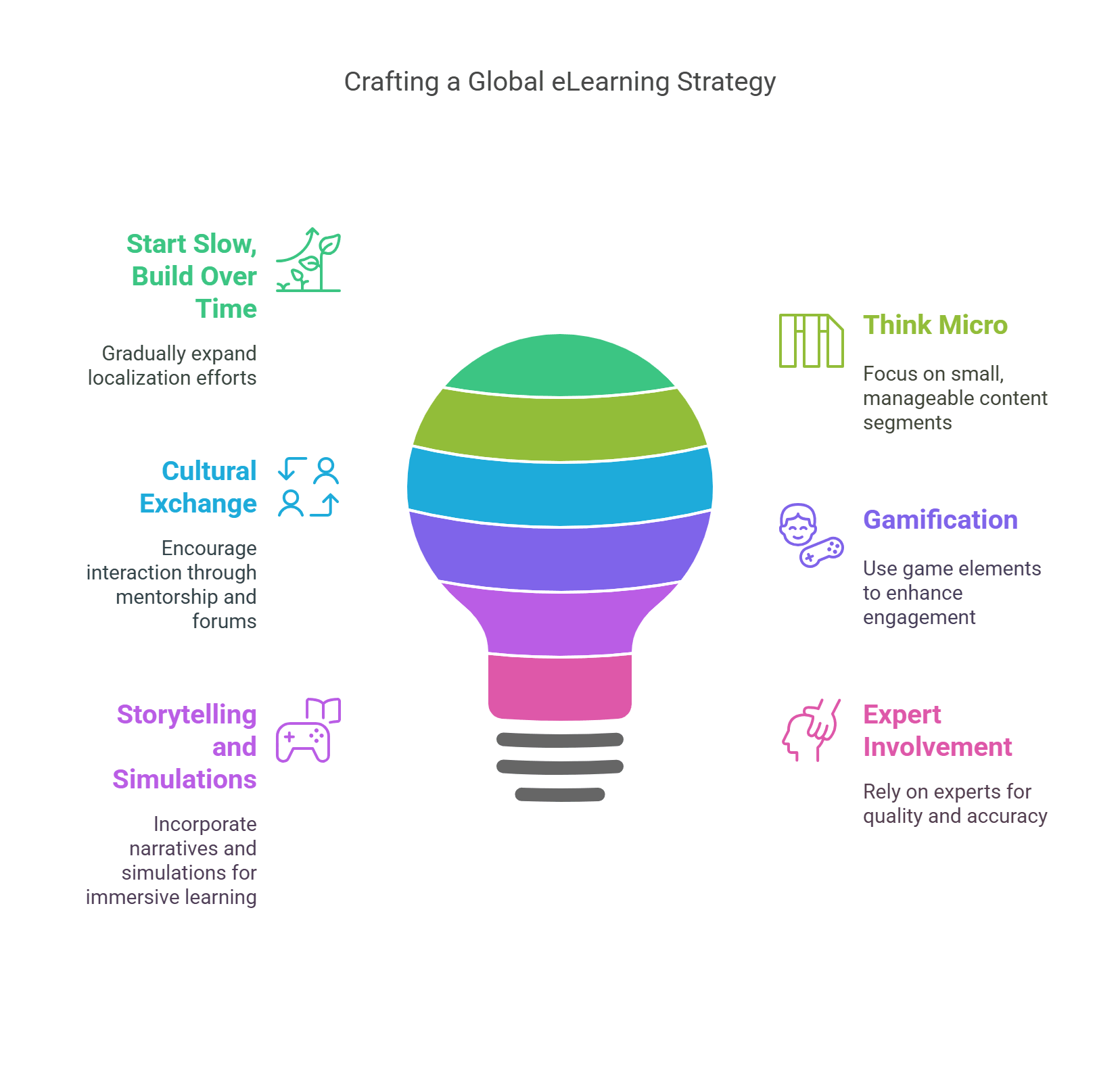
Expanding Globally? Don’t Overlook eLearning Localization!
Summarize with:
The modern era is the era of eLearning! Organizations and educational institutions worldwide are utilizing eLearning modules in one way or another, and eLearning localization has become more crucial than ever before.
eLearning offers multiple benefits to the organization and the learners over traditional learning. Around 60% of online learners stated that their eLearning helped them develop critical thinking and problem-solving skills.
The global eLearning market is ever-growing; it is projected to reach $840.11 billion in 2030 from $197.0 billion in 2020.
To capitalize on the rapidly expanding eLearning market, companies must ensure effective localization of eLearning modules so that they can also target non-English-speaking populations.
Table of Contents:
- What Is eLearning Localization?
- What is Corporate Training Localization?
- What is an eLearning Localization Strategy for Global Training?
- Top 6 Common eLearning Localization Challenges
- How to Overcome eLearning Localization Challenges?
- What are the Benefits of Corporate Training Localization?
- 9 Key Steps For An Effective eLearning Localization Process
- Step 1: Don’t Make eLearning Localization an Afterthought
- Step 2: Collect Global Data
- Step 3: Identify and Understand the Target Audience
- Step 4: Define the ‘What’
- Step 5: Define the ‘Who’
- Step 6: Pay Special Attention to The Design and Graphics
- Step 7: Test, Test, Test!
- Step 8: Don’t Forget to Comply with the Legal Requirements
- Step 9: Partner with eLearning Localization Providers
- Six Tips to Create a Robust eLearning Localization Strategy for Global Training
- The ‘After’ of Creating a Localization Strategy for Global Training
What Is eLearning Localization?
eLearning localization is the process of translating and adapting online training content and courses for learners speaking different languages and hailing from different cultures. English is the most popular language for web content, and around 59% of websites are in this language.
However, around 7,500 languages are spoken worldwide, six of which are official languages of the United Nations. Adapting courses and eLearning modules available only in English to other languages through an eLearning localization process can help more people access them.
Localization is more than a simple translation. It involves a nuanced approach beyond simply translating words from one language into another. It includes written content, audio and video, graphics, music, imagery, idioms and sayings, currencies, etc.
eLearning localization services are available to localize eLearning content and corporate training localization effectively. Localizing your online content ensures that it is culturally appropriate and valuable for a wider target audience.
What is Corporate Training Localization?
Corporate training localization involves a comprehensive approach to tailoring training materials for diverse global audiences. It encompasses translating and adapting resources such as eLearning videos, manuals, presentations, and promotional materials to suit different linguistic and cultural contexts. From dubbing and subtitling to ensuring cultural relevance, every element of the training content is meticulously crafted to resonate with the target audience, fostering effective learning and engagement across borders.
Translation and localization services for corporate training first translate all the textual content into the target languages. Then, the symbols, graphs, and colors are modified according to the target culture. One critical element of corporate training localization that localization services companies should keep in mind is the adaptation of formats about time, dates, currencies, units of measurement, etc.
Some training materials may include videos, voice-overs, or subtitles. These, too, need to be adapted accordingly in the target languages. Ideally, the localized training materials should appear as if they have been specifically created for the target audiences, and this is a task that only the best localization services companies can provide.
What is an eLearning Localization Strategy for Global Training?
An eLearning localization strategy plans and executes the translation and adaptation of eLearning content from one language to another. This is essential as many people prefer learning in their native language.
A study found that only 11.6% of respondents could speak a second language. There are four main parts to corporate training localization:
- The existing training modules are adapted into one or multiple languages. The language is translated, and the cultural context is infused (including phrases, examples, colloquial terms, etc.) for multilingual training.
- The content is formatted according to the expansion or contraction of the language and the direction in which it is written (LTR or RTL) to ensure ease of use.
- The content is visually adapted through graphics, colors, illustrations, videos, infographics, etc. For example, white, which means purity in one country, might mean death in another.
- The content is tested, improved upon, and updated occasionally to create a glitch-free environment that runs smoothly on native learning management systems, too.
An eLearning localization strategy broadly does these four things for an efficient and impactful global training program. But a lot lies in the details.
Top 6 Common eLearning Localization Challenges
eLearning localization providers face a few common challenges regarding the effective localization of online content.
1. Lack of Knowledge About the Target Audience
Localization of content is more than simply translating words, and thus, certain cultural norms that may impact localization may be overlooked.
That is why working only with the best localization services providers is so important to ensure effective eLearning localization.
2. Lack of Familiarity with the Subject Matter
Localization service providers may face issues translating different content niches from English to other languages, as adapting online material into other languages is difficult.
Understanding different concepts from the perspective of different cultures is the basis of effective eLearning localization. This problem may be more pronounced if a company employs freelance translators.
3. Adapting Graphics to Different Audiences
E-learning localization providers often face a major challenge: adapting graphics to different target audiences. Different cultures may decipher certain images differently, so it is important to remember cultural norms when localizing graphics and images in eLearning content.
Different cultures also assign different symbolic significances to different colors. These cultural differences should be considered when localizing content.
4. Adapting Idioms and Phrases
Idioms and phrases are often figurative and not meant to be understood in a literal sense. They have a symbolic, non-literal meaning attached to them.
The literal translation of idioms from one language to another can distort its symbolic relevance to the context. eLearning localization services providers must be aware of the source language idioms and phrases and the probable equivalents in the target language.
5. Finding the Right Tonality
Conveying the right tone in eLearning localization is a serious issue that requires attention. Writing in a conversational style is easy in languages such as English.
However, this might not be possible in many other languages like Arabic or German. The tonality aspect needs to be considered while localizing online courses from English to other languages.
6. Formatting Currencies and Symbols
Not all course materials are entirely composed of words. In addition to the words, symbols for currencies, date formats, and graphic content also need to be localized.
Different cultures interpret symbols differently and may use different formats for dates and times. Only the best eLearning localization providers could effectively format symbols and currencies from one language to another.
How to Overcome eLearning Localization Challenges?
While it is true that eLearning localization comes with several practical challenges, there are a few steps every organization and educational institution can take to overcome these issues efficiently. One can start planning their eLearning localization strategy early in online course development to make localizing the content easier.
Planning will help organizations minimize the impact of challenges and prepare to face them as and when they arise during the localization process. Proper planning can even eliminate a few challenges, such as ambiguity in the usage of idioms and symbols.
Course developers can leave extra space within original designs to allow for text expansion when the original content is in English. Creating pre-optimized content for eLearning localization makes the actual localization process easier later on.
While developing online course content, educational institutions can choose to work with localization services companies to ensure that their courses are pre-optimized. Agencies with expertise in eLearning localization can support organizations through the entire process of creating online training and educational modules.
Understanding and overcoming eLearning localization challenges for multicultural audiences is crucial for any company that wishes to localize its learning modules for diverse groups of learners.
What are the Benefits of Corporate Training Localization?
eLearning localization is a complex process that, if done right, can bring about numerous benefits. When it comes to global corporate training programs, offering your diverse employees the chance to access the training modules in their native languages will not only enhance the efficiency of the training but also build employee loyalty.
1. Improve Engagement and Retention
People are more likely to resonate with content presented to them in their native language. Therefore, one of the biggest benefits of corporate training localization is that it improves employee engagement and helps them retain the knowledge gained.
Content that reflects their cultural views ensures that they understand the context better. You can hire eLearning localization services agencies to adapt your training materials according to your employees’ cultural and linguistic backgrounds.
2. Promote Diversity and Inclusion
With localized training materials, organizations signal to their staff members that they are committed to creating an environment that supports equitable learning for all. Localized training modules show your employees that you care for their diverse cultural backgrounds.
eLearning localization helps promote inclusivity and diversity in the workplace by making people from different cultural and linguistic backgrounds feel welcome.
3. Standardization
eLearning localization of training modules helps you standardize your content and make it appropriate for different target audience segments. Localization is more than simply translating the textual materials. It considers the adaptation of images, usage of colors, different symbols used for currencies, date and time formats used in other cultures, and adaptation of idioms and phrases. This helps convey a uniform message without ambiguity to employees from different cultures.
4. Legal Compliance
In some countries, companies are legally required to provide their workforce with training materials in their native language and English. Corporate training localization in such cases becomes legal compliance, besides enabling you to conduct your training more effectively.
5. Maximize ROI on Learning Initiatives
Localization makes your training content more relevant and easily understandable. It enables your employees all around the globe to comprehend important information most efficiently, thereby boosting their productivity.
Well-trained staff members are more likely to utilize the skills they learn in real-life situations and deliver superior work. Over a while, this enhanced employee efficiency will be reflected in the company’s profitability.
6. Optimal Resource Utilization
Creating brand-new content for different segments of people speaking different languages would be an extremely resource-intensive process. For companies with branches globally, eLearning localization is the best option for optimal resource utilization regarding training materials.
9 Key Steps For An Effective eLearning Localization Process
We’ve created a step-wise eLearning localization strategy that ensures you’ve covered all grounds.
Step 1: Don’t Make eLearning Localization an Afterthought
If planned during the early stages of creating the eLearning modules, you can save time and resources to localize the content. For example, if the planning begins at inception, you can use simpler graphics, global fonts, universal stories, idioms, slang, etc.
Factor in the contraction and expansion of a language (when translated from English, for example, the length of a module in Japanese could be longer) or the direction is written. With this, when the time comes for localization, massive changes don’t need to be made to the content.
Step 2: Collect Global Data
Think big. Think global from the beginning. Decide what countries could be your potential markets. Speak to the people there, understand the language and the customs, and gather as much data as possible.
You could create a questionnaire to organize the information you get and turn it into knowledge later. Having this data at hand right at the beginning can remove the biggest stumbling block for eLearning localization.
Step 3: Identify and Understand the Target Audience
You may start the localization process with one or two languages. Where are most of your employees or students from? Pick that country and start with it.
As a starting point, you can look at your website analytics or the location from where most of your customers are from, etc. Once you have identified the target audience, learn more about their customs. The devil is in the details.
Colors, measurement units, the side of the road where you drive — all those little things make an eLearning localization process successful. For example, purple may mean royalty in Britain but means death and mourning in Thailand.
Step 4: Define the ‘What’
The next step might sound easy, but many fail here. What do you want to localize? It can get complicated if you begin localizing all of your content simultaneously.
Start with what’s most important, learn from it, and then apply your knowledge to a broader canvas. You may start with the three most important or high-performing modules. Brainstorm with your team on where to begin.
Step 5: Define the ‘Who’
Set up a team of experts who can handle the eLearning localization process. They don’t have to be the ones who localize it if you are engaging with a localization partner providing eLearning localization solutions. But assign responsibilities to different people and hold them accountable.
Who will do the quality check? Who will track the performance metrics? Who will manage the project? And so on? This will establish accountability and keep your localization process on track.
Step 6: Pay Special Attention to The Design and Graphics
Focusing on the graphics and design of your modules, along with the language, matters significantly. Some symbols used in one country might offend the people of another or not make the point.
Say you have a video where the instructor uses different gestures common in the United States, but they may attract confused looks in Japan. Avoid misinterpretation of the course content and design it thoughtfully. Consult localization experts to avoid making mistakes.
Step 7: Test, Test, Test!
Do a beta test in the target market before you make the content live to the public. This will be like mining for gold. You’ll hear it straight from the horse’s mouth and still have time to improve the eLearning modules. This is also a sure-shot way to avoid offending people.
You can also check for technical issues through the test. For example, a feature-rich module may not work in areas with limited connectivity. You can also check for other bugs and fix them before it goes live to create a seamless user experience.
Step 8: Don’t Forget to Comply with the Legal Requirements
There are many regulatory topics for digital learning solutions, such as data privacy, intellectual property, accessibility, educational norms, and piracy. These vary from country to country.
Non-compliance could result in complaints and legal proceedings that could temporarily stay or permanently ban the module in that area. This would mean you’d either need more resources to navigate the legal issues or let the ones you used to localize the module go to waste.
Step 9: Partner with eLearning Localization Providers
The best approach to an eLearning localization process is to hire someone who knows what they’re doing and avoids all the potential pitfalls.
Experts like Hurix Digital provide eLearning and training solutions for various verticals. These can be gamified, customized, simulated in sync with the business context, combined into learning paths, etc., and localized.
Six Tips to Create a Robust eLearning Localization Strategy for Global Training
Before creating a strategy for corporate training localization, collect enough data after researching your employees in the target country.
What are the kinds of skill gaps that need to be bridged? What areas of training do you need to focus on? What is common, and what isn’t? Answer those questions.
Then, follow the training localization best practices you discover that most will not tell you about. Let us dive in!
1. Start Slow, Build Over Time
Think of your global training localization strategy as multiple blocks of different colors. Each color represents a country.
Now, if you go all-in, you may not be able to incorporate the learnings of one localization project into another. So start with one or a few countries for your global training program and then expand.
2. Think Micro
Turn the eLearning content into bite-sized training modules that improve comprehension.
These micro-learning modules also enhance the accessibility of the training program as they factor in diverse learning preferences for all your employees. They also help better understand and have easier comprehension, boosting the program’s overall success.
3. Go for Cultural Exchange Through Mentorship and Forums
Introduce people exchanges as part of your eLearning localization strategy for global training. Arrange for mentors from different cultures as a part of cross-cultural communication in training.
You can also open forums for employees to ask their doubts or engage with each other to make your training modules enjoyable and value-filled. This facilitates a healthy cultural exchange. Paired learning can also add to your strategy.
4. Bank on Gamification
If your organization is based in a company with a culture very different from the country you are looking at next, you might face some resistance. You can navigate this challenge through localized gamification in your training content.
Gamification also leads to a more engaged, passionate, and innovative team. You can use rewards common to the region and introduce cultural context in a fun way to break the ice. This can increase employee retention and foster trust.
5. Introduce Storytelling, Simulations, and Scenario-Based Training
Storytelling, simulations, and scenario-based training are among the most effective ways to connect with your employees and enhance learning through relatability. A narrative also makes the content more dynamic and entertaining.
You can use folk stories or make the lead characters like the region’s people for which you are employing an eLearning localization strategy. Storytelling, simulations, and scenario-based learning can also make the training module relevant and increase employee engagement.
It is one of the best ways to adapt the content by infusing cultural context.
6. Let the Experts Take Care of it
Experts can be the difference between making or breaking it. eLearning localization strategy specialists like Hurix Digital have years of experience and offer end-to-end solutions to localize your training modules. Armed with a bouquet of software localization services and knowledge, they can streamline your strategy and increase productivity.
Bonus: Integrate your global training modules with the local learning management systems to promote ease of use. Ensure compatibility while migrating data during the localization process, or let an expert test everything for you before the rollout.
The ‘After’ of Creating a Localization Strategy for Global Training
Localization strategies for global training involve constant creation. Once you are done building one, you need to test it, track its performance metrics, and see if it meets your goals.
But even after that, as your global workforce changes, you must keep adding, removing, and modifying your global training content. Plan early, do it at the right time, integrate learner feedback, and hire an expert like Hurix Digital to get flawless results with their localization services.
Hurix Digital has an expert team of linguists, multimedia and instructional designers, and localization engineers with access to artists, proofreaders, and the right personnel you need for a project of such magnitude.
Our eLearning localization services use Robotic Process Automation, provide Quality Assurance Testing and a host of other services to create immersive and relevant training modules that can also have add-on features like gamification or scenario-based learning. Get in touch with us today!
Summarize with:

Senior Vice President
Julia brings over 20 years of global experience in digital learning and business strategy. She specializes in client success, enterprise learning solutions, and driving growth through innovation, with a focus on AI, VR, and emerging technologies across diverse industry verticals.
 A Space for Thoughtful
A Space for Thoughtful 







